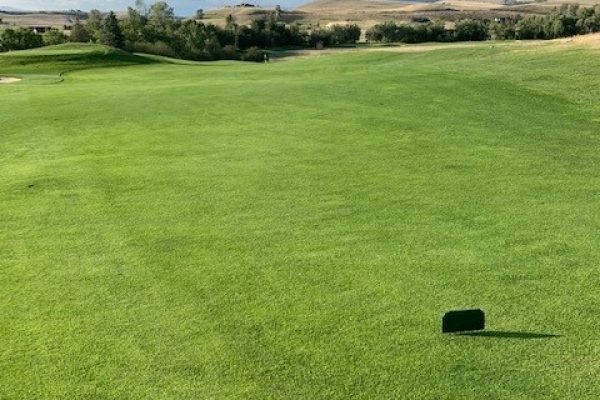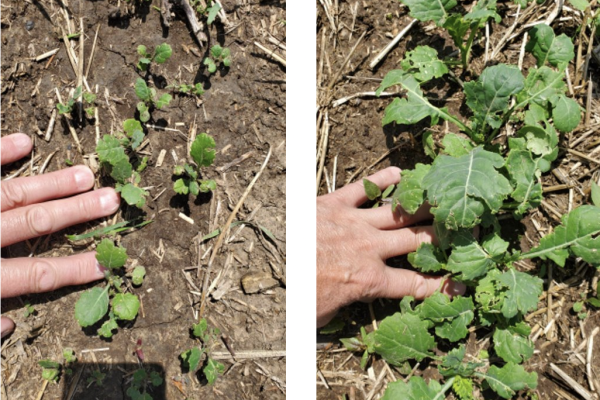Healthy soil is the foundation of productive, sustainable agriculture. Managing for soil health allows farmers to work with the land – not against – to reduce erosion, maximize water infiltration, improve nutrient cycling, save money on inputs, and ultimately improve the resiliency of their working land. With a three-part series, Replenish Nutrients hopes to break down barriers to understanding and implementing forms of regenerative agriculture. In our first article, Regenerative Agriculture: Hype or High Profit, we tackled common myths surrounding the farming practice. In this piece, we invited cattle rancher and ag-tech enthusiast, Jason Bradley, to take us on a deep dive into why farmers should care about soil health and usable best practices.
From food to water to various ecosystems, healthy soil is the foundation for all living creatures. But soil erosion and loss of biodiversity are threatening agricultural productivity and amplifying climate change. Thankfully, more and more corporations and growers are becoming interested in sustainable conservation practices — namely, regenerative agriculture.
Unfortunately, as Initiative on Agriculture Director, Pam Lewison, declared in a recent article regenerative agriculture has an audience problem. She noted that, despite the many potential positive outcomes associated with the methodology, most proponents of the practice tend to look less like conventional farmers and more like Hollywood hippies. Which has led to a schism in the industry.
“It’s true,” exclaims Jason Bradley, cattle rancher and ag-tech enthusiast. “Farming is generations old. It’s a proud and personal way of life. Farmers who practice regenerative agriculture principles can find themselves questioned by friends and family when they go against conventional farming practices.”
It’s more powerful to be for something than against it.
Most of the ‘us versus them’ mentality could be fixed with a solid understanding of regenerative agriculture.
“You can apply regenerative practices to any type of farming. It is not an either/or proposition; it’s and/or,” Jasons explains.
By its most basic definition, regenerative agriculture is simply nature-based. It’s adding to soil to improve organic matter and overall health. Working with nature, not against it.
“Conventional farming takes the approach of feeding the plant, not the soil. And generally that feeding happens with man-made, chemical nutrients. This ends up being counterintuitive. Plants extract more life out of the soil and mine the soil for its goodness. But if all the nutrients are diverted to plant growth, the soil is constantly degrading.”
Considering the world grows 95 percent of its food in the uppermost layer of soil, topsoil is one of the most critical food system elements. Unfortunately, about one-third of the world’s topsoil is already acutely degraded. Even more frightening, 52 percent of global lands used for agriculture are moderately or severely degraded.
But nature-based systems such as regenerative agriculture help to turn the tide by treating the soil as a living organism.
“Regenerative agriculture relies on the complex synergies created by multi-crop rotations and the integration of livestock. These methodologies lead to healthy soil, capable of producing high quality, nutrient-dense food.”
The focus here is on soil biology and soil health resulting in a myriad of benefits including deeper roots system, improved nutrient uptake, and increased water retention. Overall, plants are more pest-resistant and vital soil organic matter thrives. Restoring and regenerating soil health safeguard farmers’ livelihoods and lowers operational overhead, potentially saving farmers thousands in input costs.
Regenerative practices increase profits.
Crop yields are an essential aspect of every farmer’s day, impacting how profitable their farmland can be. But focusing on yields alone has created a lot of problems for farmers.
“It’s the three-legged stool: profitability, productivity, and sustainability,” Jason explains.
“Yield is important,” he continues. “But if you can decrease your inputs and maintain your yield, that’s profit. After all, you’re saving money from reduced dependency on chemicals for crop protection.”
When farmers begin looking at productivity and yields while keeping one eye on sustainability, profits follow. Successful generational farming operations that survive over time are usually highly resilient, adaptive, and highly diverse. Resilience is critical because most agroecosystems face conditions (including climate, pest populations, etc.) that are often highly unpredictable and rarely stable in the long run.
“Diversity leads to resilience. If there’s a market issue or disease, through crop diversification, you’re de-risking those catastrophes.”
There are more advantageous reasons to use regenerative ag practices than merely to lessen tragedies. A study by Ag-tech company Indigo Ag concluded that even using just 15 percent of corn, soy, or wheat fields, farmers who employed no-till and cover crop tactics could generate an additional $600 million “by reducing costs, bolstering soil productivity or selling carbon credits”.
This doesn’t mean that there isn’t a trial and error period as producers begin experimenting with new technologies and methodologies.
“There’s so much potential as we continue to understand the synergy and how things work together – how different plants work together in multi-plant variety instances, how livestock and plants work together. When we leverage the value out of these methods, it drives profitability, increases yields, and improves soil health.”
However, Jason warns that “profitability takes time. In Canada, we only have one growing season per year to work with and that means everything we do on the farm has consequences. To learn how to increase crop production and crop yield, we have to approach each decision with a different perspective.”
Regeneration for the risk-averse
For those interested in regenerative agriculture, Jason reminds producers to be patient.
“Achieving a high level of soil health and profitability takes time. It’s not instantaneous. But nothing we do in agriculture is. Expect three to five years before you see positive changes in the land and to your bottom line.”
When it comes to adopting regenerative practices, there are a few simple steps farmers can begin to implement to set themselves up for success.
Be open-minded.
Thanks to the plethora of different regenerative agriculture methods, there’s no one size fits all approach. Just because a particular practice works for someone else’s current situation or area doesn’t mean that it will automatically work for you.
“You don’t just wake up one day and declare you’re a regenerative farmer. You first need to make sure it works for you as a businessperson.”
Whether it’s low- or no-tilling, livestock grazing, crop cocktails – the list is practically endless – it has to work for you and the tools you have on hand.
“Try to understand how growing grain and raising livestock intertwine. Include production costs into profitability. It’s easier for someone who can integrate cover crops with livestock as opposed to a straight grain producer who will have challenges trying to convert their lands.”
Start small.
Farming is one of the world’s oldest professions, and nature-based practices like regenerative agriculture are just as ancient.
While many global corporations including Nestle, Cargill, and Panorama (among others) have pledged to regenerate the natural resources they depend on, most family and conventional farms don’t always have the same resources to dive right into change. And they really just shouldn’t.
“Work with the tools you have. Figure out what small shifts you can begin first. From there, you can start with small steps, maintaining profitability,” Jason advises.
Take cues from the tech sector.
The technology startup scene is notorious for failing fast. And that’s a characteristic farmers can embrace.
“Mistakes are expensive,” reminds Jason. But if you fail fast and fail small, it’s not as costly. And it can eventually lead to higher, sustainable profits. So allow yourself the opportunity to fail.
As Jason explains, find your regenerative agriculture minimum viable product (MVP). Make sure this product or system works for your business and that your customer or market wants it.
“If you have 100 acres, use regenerative practices on 10 of them. This is your MVP. Can you sell the cover crops? Is grass feeding your cattle valuable to your supply chain?”
Change your perspective and support one another.
Farmers are the country’s backbone but tend to act more like the femur… known to be a bit rigid. Especially when it comes to change, that’s why it’s imperative we feel comfortable talking about new methodologies.
“Leadership roles are important factors for more rapid adoption of new systems. It helps to ask open-ended questions and offer support to neighbors trying new approaches.”
Conservation practices benefit us all. But unless we can discuss techniques in an open, honest, and collaborative forum – from a farming perspective – innovation stagnates.
The messy middle
As Petra Hans, head of portfolio, agricultural livelihoods at IKEA Foundation wrote, “agriculture doesn’t have to be the villain”. And the generally relaxed character of regenerative agriculture helps the industry maintain this position.
Regenerative agriculture is not a set of hard and fast rules. Unlike organic farming, there is no certification to achieve – or worry about losing. No regulations you have to follow. As Jason explains, regenerative agriculture “is not a dogma; it’s merely doing things differently with the goal of creating healthier soil.”
For this reason, the regenerative approach means learning how to function in, what Jason refers to as, “the messy middle.”
“There might be some years you have a weed infestation problem where you need to use a herbicide.”
This allows farmers to use conventional practices without the fear of losing credentials or standings.
“It’s not thou shalt or thou shalt not. If something works, use it.”
###
Subscribe to Replenish Nutrients for breaking news and recently published articles. And follow us on Twitter and Facebook for the latest updates and behind-the-scenes information.
About Jason Bradley
Jason Bradley has a multi-faceted career in technology, cattle ranching, and academia. This stems from early-career roles at a multi-national telecommunication enterprise in senior manufacturing and project management positions, two decades as the Vice President of Operations at Red Deer River Ranches, and recently as the Director of Smart Ag and Manager of Strategic Partnerships at Olds College.
The idea of trying something new, the practice of design thinking, and a predisposition for connecting people and ideas has led Jason into opportunities in agriculture production, ag-tech innovation, and ecosystem development. A drive for understanding and demonstrating the practice of nature-based systems has brought him to develop a passion for regenerative agriculture.
Jason is currently working on his Master of Arts in Leadership at Trinity Western University. He is researching how collaboration, team leadership, and people development are integral to transformational servant leadership and its values and ethics.


